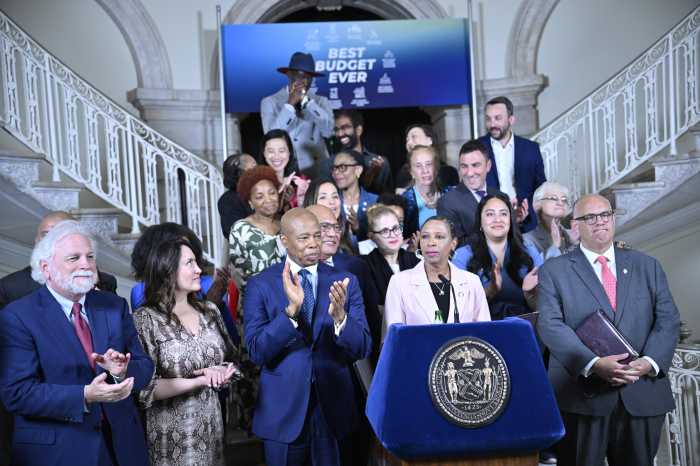
As a food journalist, lawyer, and mom of two, Andrea Strong is passionate about children having access to healthy food and nutrition education. On Sunday, she led more than 100 people at the March for Healthy School Food in NYC.
The founder of the NYC Healthy School Food Alliance said that many schools are not doing enough to provide proper nutrition and nutritional education programs to students — especially to those who are low income. According to the Centers for Disease Control and Prevention, approximately 13.7 million young Americans between 2 and 19 years of age are obese in the U.S.; the most impacted of those are in low- to middle-income households.
“Right now our menu is bag to oven and we want real food made by real people served to our children,” Strong said. “It’ll increase jobs, it’ll help our economy, and most of all it’ll help our children.”
Fewer than 10 percent of children nationwide eat the recommended daily amount of vegetables and fewer than 40 percent of American children eat the recommended amount for fruits, according to the CDC. In New York State, there are no early care and education licensing regulations aligned with the national standards for serving fruits or vegetables.

Representatives of the NYC Healthy School Food Alliance and other advocates at Sunday’s march called on local officials to implement four changes to kindergarten through fifth-grade schools: More freshly prepared meals, culinary and nutritional education, gardens at every school to teach kids how to cultivate food, and longer times for lunch so students have time to properly eat their meals.
For Downtown Brooklyn resident Shanna Hayes, implementing such measures is essential for her 8-year-old son, who has autism. Since she started focusing on healthier meals and lifestyle choices at home about three weeks ago, she said she has already seen her son’s focus improve and his hyperactivity lessen. Hayes said that even though some may resist paying for an increase in school lunch programs, the costs will manifest down the road eventually. Without healthier lunch options, she said, parents will end up paying for chronic health issues, such as diabetes, that their children develop in the future.
“They say that no children are left behind, but our children are being left behind every day when they have to eat something that’s not healthy for them,” she said. “Our children are being left behind every day when they have to spend more time at the doctor than they are at school because they’re sick.”
Brooklyn Borough President Eric L. Adams agreed.
Adams helped lead Sunday’s march across the Brooklyn Bridge into Manhattan. Along the way he chanted support for nutrition reform into a megaphone, advocating for a cause that hit home when he suffered from temporary blindness and nerve damage associated with diabetes.

“Our children are not only going to school to learn reading, writing, and arithmetic. They’re also going to school to learn how to be unhealthy,” he said. “It’s unbelievable that we can actually do something about childhood obesity, childhood diabetes, childhood asthma. … When we look and see how simple this is, all there needs to be is desire in how we reeducate children.”
Adams said that the city’s implementation of "Meatless Mondays" in the 2019-2020 academic year is a good start. He is also working on helping put greenhouses and gardens at schools while getting rid of processed meats. He and Strong say that not only will such measures improve student’s health, they will lead to a healthier lifestyle that can be directly correlated to better grades and fewer absences.
“I feel like all kids get really excited when you teach them nutrition education and teach them how to grow their food,” Strong said. “We are hoping to raise our voices and raise awareness of the health crisis in New York City and the role that school food plays in feeding that crisis.”





































